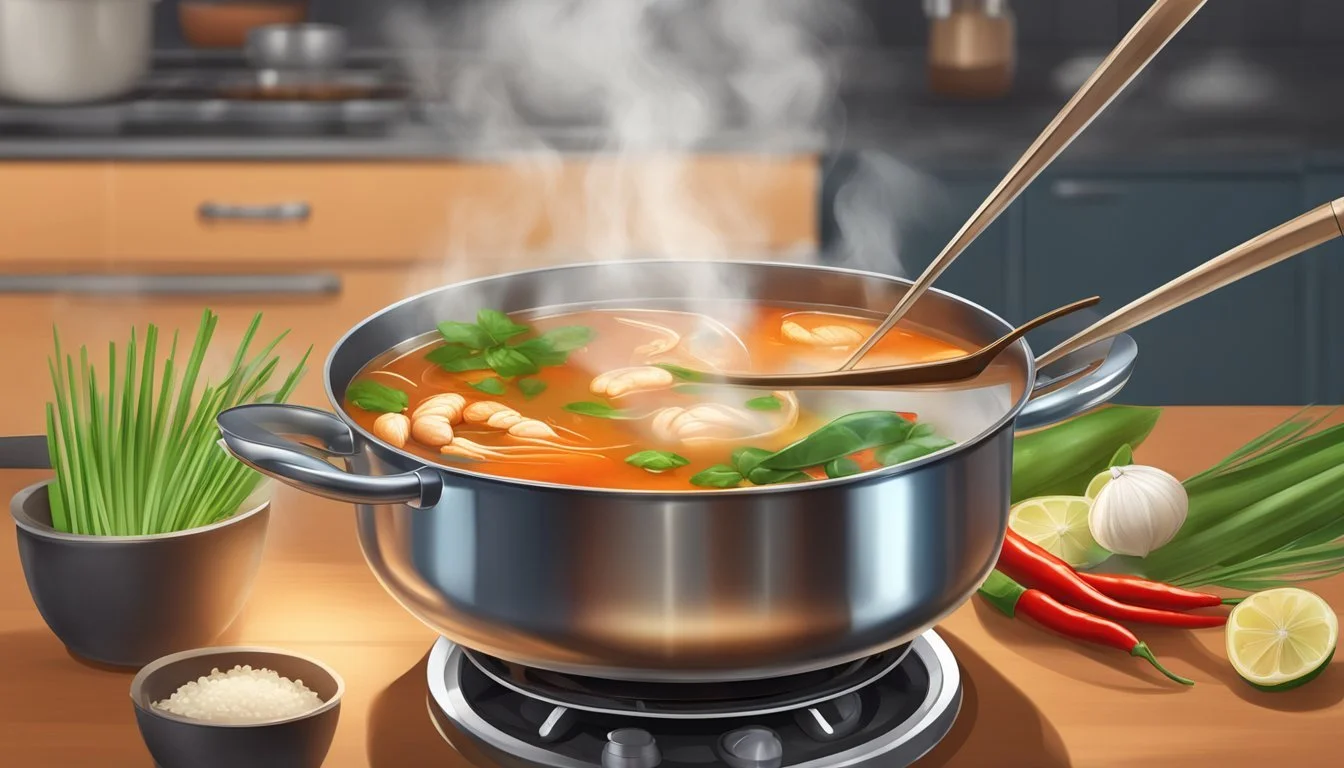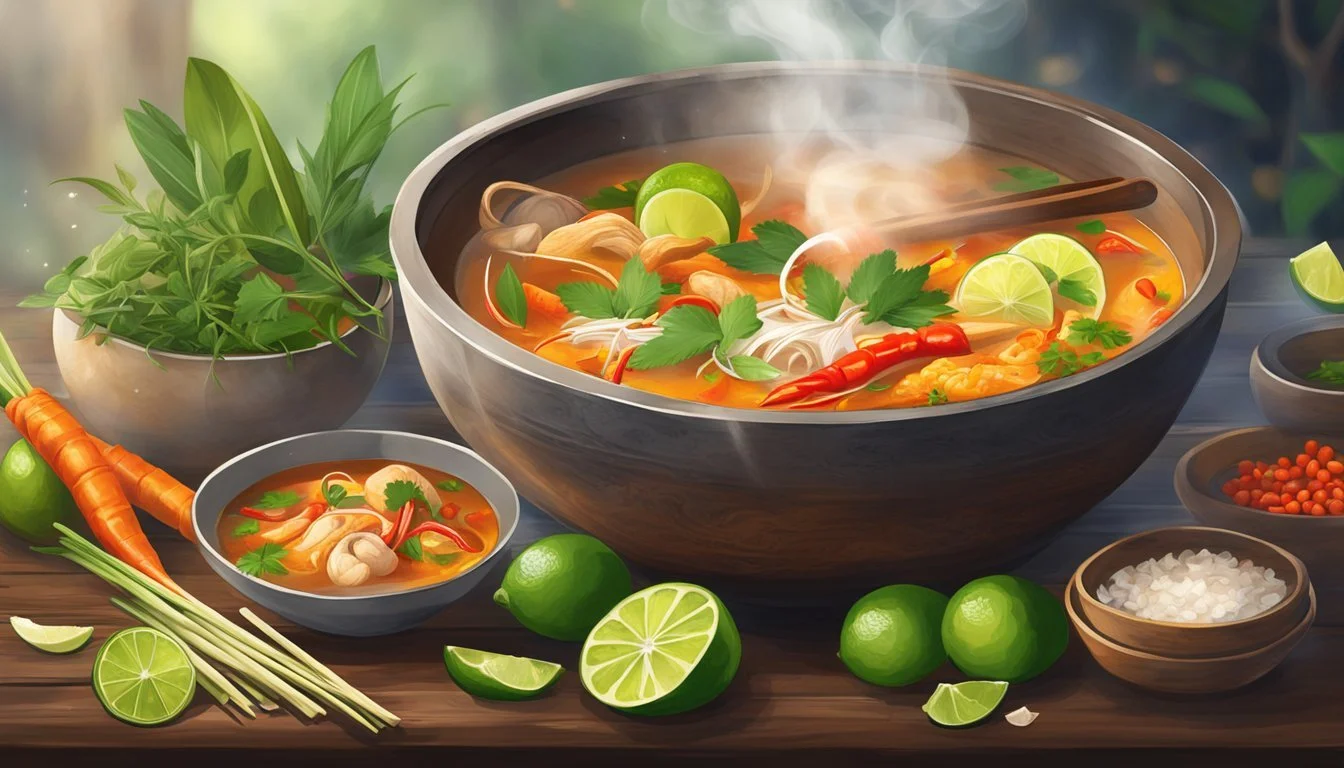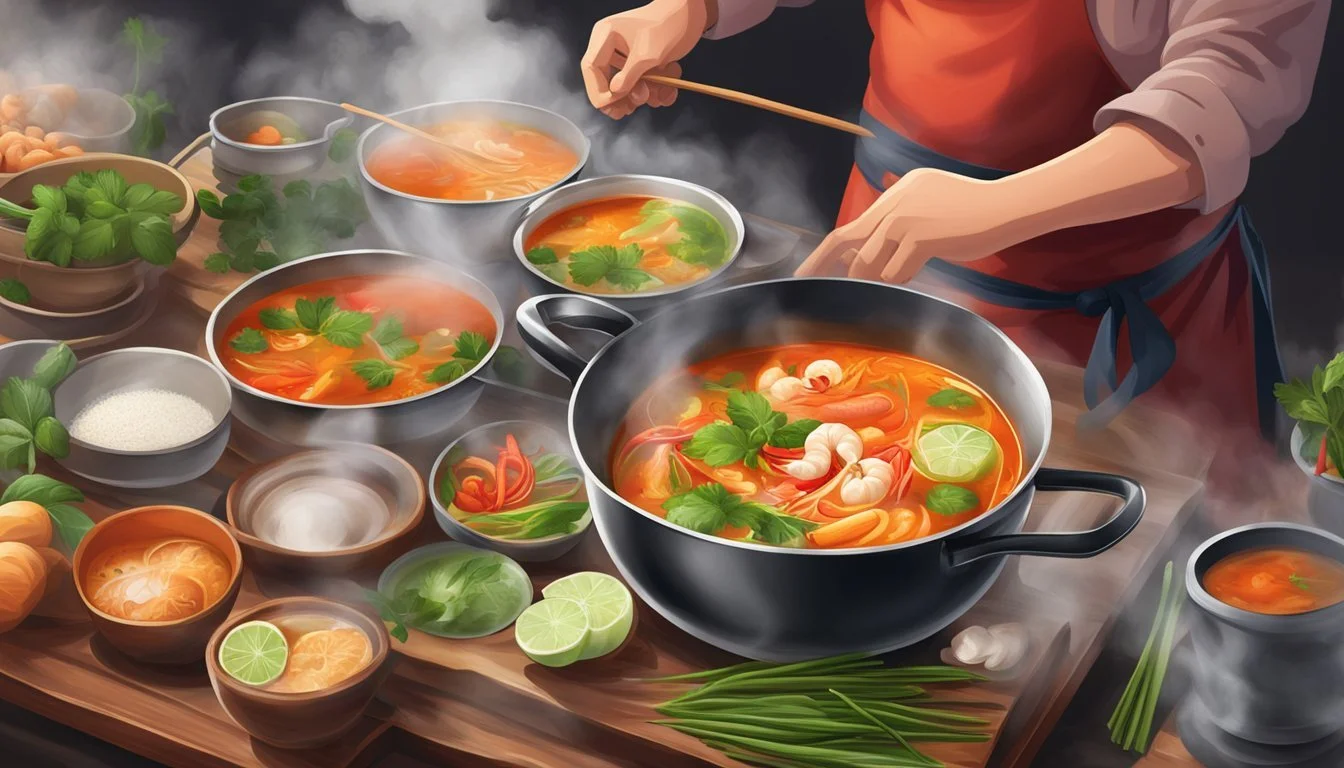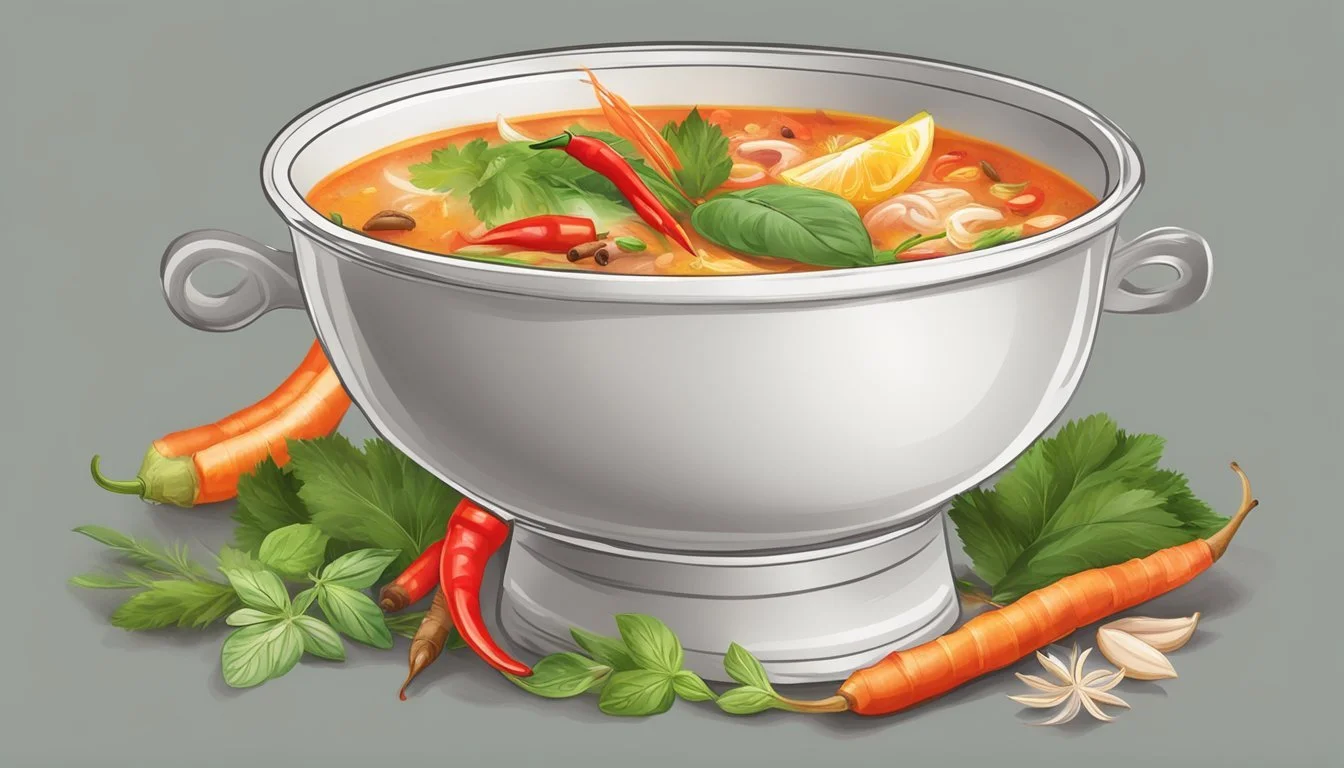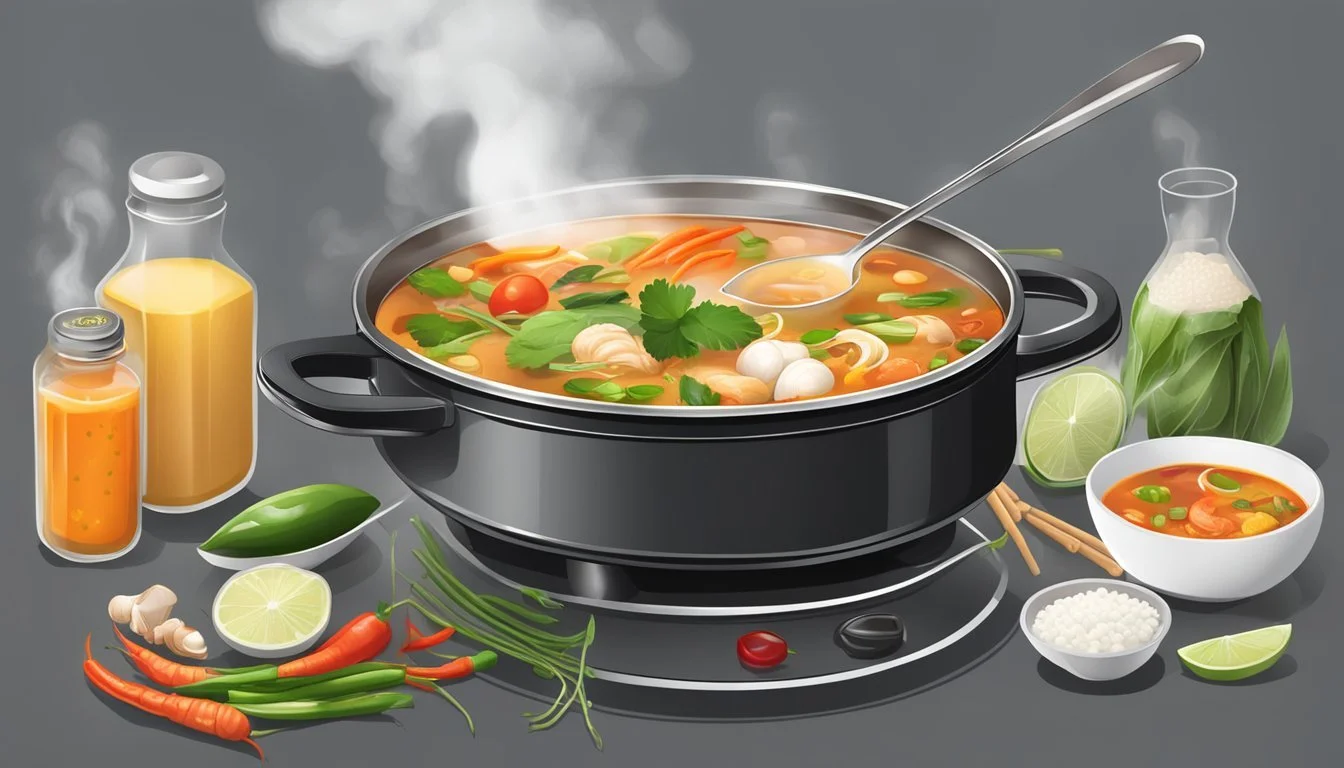Best Way to Reheat Tom Yum Soup
Preserve the Spiciness with These Methods
Tom Yum Soup is a cornerstone of Thai cuisine known for its bold, spicy flavors and aromatic components. It features a harmonious blend of lemongrass, kaffir lime leaves, galangal, and chili paste, which creates a distinctive hot and sour profile revered by spice enthusiasts. The challenge when reheating Tom Yum Soup is to maintain its vibrant taste and the delicate balance of its spicy kick without compromising the texture and freshness of its ingredients, like shrimp (What wine goes well with shrimp?) and vegetables.
Reheating methods play a crucial role in preserving the soup's integrity. The stovetop approach is generally preferred as it allows for gradual heating, which is essential for preventing the seafood and vegetables from becoming overcooked and mushy. The process involves carefully warming the broth on its own and reintroducing the solid elements later, ensuring they just get enough heat to be warmed through without cooking further.
When it comes to retaining the full spectrum of Thai flavors, especially in Tom Yum Soup, attention to detail is paramount. Factors such as the duration of reheating, the point at which condiments are added, and the way the ingredients are handled, will influence the final outcome. A properly reheated Tom Yum Soup should present as if it's freshly made, with the same aromatic zest and punchy heat that one expects from this beloved Thai dish.
Understanding Tom Yum Soup
Tom Yum Soup is a quintessential Thai dish known for its distinctive spicy and sour flavors. At its core, the soup consists of a broth infused with aromatic herbs and ingredients fundamental to Thai cuisine, each contributing to the soup's unique taste and aroma.
Key Ingredients:
Lemongrass: Imparts lemony scent and fresh flavor.
Galangal: A rhizome similar to ginger, adds a sharp, peppery taste.
Kaffir Lime Leaves: Lends a strong citrus note.
Fish Sauce: Provides a salty depth.
Thai Chilies: Introduces controlled heat.
Cilantro (Coriander): Offers a fresh, citrusy finish.
A traditional Tom Yum recipe involves a delicate balance of these components, creating a harmonious blend that excites the palate with every sip. The soup is commonly brimming with mushrooms (What wine goes well with mushrooms?), tomatoes, and proteins like shrimp, enhancing the texture and heartiness of the dish.
The soup's aroma is as inviting as its taste, with citrusy and herbal notes wafting from the hot broth. Authentic Tom Yum is made by simmering these ingredients, allowing their oils and essences to permeate the liquid. The result is a broth that is at once spicy from the chilies, tangy from the kaffir lime leaves and lemongrass, and layered with the earthy tones of galangal and fish sauce. Perfectly balancing these elements ensures the soup retains its characteristic boldness and Thai essence.
In the realm of Thai dishes, Tom Yum stands out for its boldness, embodying the essence of Thai flavors that are adored globally. It is a soup that satisfies cravings for spice while remaining refreshingly sour, making it an unforgettable staple of Thai cuisine.
Key Ingredients and Their Roles
Tom Yum Soup is celebrated for its vibrant bouquet of flavors and aromas. Achieving the perfect harmony calls for precise use of key ingredients, ensuring the soup's spicy kick remains intact while layers of flavor unfold.
Protein Choices and Their Impact
Protein imparts both flavor and textural nuance to Tom Yum Soup. Common choices include shrimp, known for its sweet and tender profile, and chicken, offering a milder taste. Fish or mixed seafood can also be utilized, each adding a distinct depth to the broth.
Vegetable Contributions to Flavor
Mushrooms, particularly oyster mushrooms, introduce an earthy flavor, whereas tomatoes add a natural sweetness and slight acidity. These vegetables are essential for creating a balanced, full-bodied soup.
Authentic Herbs and Spices
The soul of Tom Yum Soup lies in its herbs and spices. Lemongrass, galangal, and kaffir lime leaves are quintessential, each contributing a fragrant, citrusy kick. Garlic and ginger add layer upon layer of aromatic warmth to the dish.
Acidic and Aromatic Elements
Lime juice injects a burst of sourness, while the zest of lime leaves heightens the soup's fragrance. Together, these elements bring a refreshing acidity that is pivotal in balancing the overall flavor profile.
Balancing Heat and Sweetness
Achieving the characteristic spicy kick hinges on the use of Thai bird’s eye chilies and nam prik pao (Thai roasted chili paste). The heat is often counterbalanced with a hint of sugar to create a pleasing complexity.
Supplemental Ingredients for Depth
Additional elements like fish sauce for umami and coconut milk for creaminess further enrich the soup. These components contribute to underlying flavors that support and enhance the primary notes of the Tom Yum.
Stocks and Broths as a Base
A robust broth forms the foundation of Tom Yum Soup — be it chicken stock, shrimp stock, or a simple yet flavorful chicken broth. The choice of liquid base is crucial as it must carry and meld the diverse flavors from the proteins, vegetables, herbs, and spices without overpowering them.
Preparation Before Reheating
Before reheating Tom Yum Soup, it is essential to address proper storage and preparation to maintain its vibrant flavor and spicy kick. This includes cooling and storing the soup promptly, freezing techniques, adequate thawing, and separating specific ingredients.
Proper Cooling and Storing
To ensure the Tom Yum Soup retains its quality, cool it quickly after cooking. Shrimp and chicken should be removed from the broth to prevent overcooking during the reheating process. The soup should then be stored in an airtight container to preserve the flavors. If storing in the refrigerator, it should be consumed within two days.
Tips for Freezing Tom Yum Soup
Freezing Tom Yum Soup can extend its shelf life but must be executed carefully:
Cool the soup completely before freezing to prevent ice crystal formation.
Use freezer-safe containers or bags and leave some space for expansion.
Separate delicate ingredients like mushrooms and tomatoes from the broth. These can be frozen individually in plastic wrap or containers.
Pre-Reheating Thawing Techniques
When ready to enjoy the soup, proper defrosting is key:
Defrost in the refrigerator overnight to ensure even thawing.
For a quicker method, place the container in a bowl of cold water, changing the water every 30 minutes.
Avoid using a microwave to defrost as this can affect the soup's texture and flavor.
Sectioning Ingredients for Reheating
Separating the soup's components before reheating will help maintain the integrity of each ingredient:
Keep the shell of shrimp aside to avoid rubbery texture upon reheating.
Reheat the broth on its own and return the shrimp, mushrooms, and tomatoes to the soup only after the broth is hot.
This method keeps the delicate ingredients from losing their texture and ensures the soup heats evenly.
Best Reheating Methods
To ensure the Tom Yum Soup retains its vibrant flavor and spicy kick, proper reheating techniques are crucial. Let's explore the best methods that allow for preserving the soup's quality and taste.
Using the Stovetop for Optimal Control
The stovetop method provides the most control over temperature, which is essential for not overcooking the delicate ingredients in Tom Yum Soup. One should gently reheat the broth on medium-high heat. It's advisable to remove shrimp and vegetables before heating, then re-add them after the broth is hot to avoid overcooking.
Microwave Reheating Approach
The microwave offers a quick reheating option, although one must be cautious to not diminish the soup's flavor. To use the microwave, tom yum should be placed in a microwave-safe bowl, covered with a lid or plate to retain moisture. Heating should begin at 30-second intervals on medium power, stirring occasionally to distribute heat evenly.
Oven Reheating Method
Although not commonly used for soup, the oven can be a viable option for reheating Tom Yum Soup. Thaw frozen soup at a low temperature, around 325 degrees Fahrenheit, to prevent rapid temperature changes that can affect flavor. Initially, warming a portion of soup in warm water can help to loosen it before placing it into the oven, followed by heating in a saucepan for a few minutes until heated through.
Finishing Touches for Reinvigorated Flavor
After reheating the Tom Yum Soup, it's essential to fine-tune its flavors to ensure the soup maintains its signature spicy kick and rich aroma. This includes careful adjustments to spiciness, sourness, and the aromatic freshness that defines this classic dish.
Adjusting Spiciness After Reheating
To amplify the heat in Tom Yum Soup after reheating, one should consider adding fresh Thai chilies or a teaspoon of Thai chili paste. This adjustment must be done with caution, as the spiciness can intensify quickly:
Thai Chilies: Start with half a chili, finely sliced, and add more to taste.
Thai Chili Paste: Stir in small amounts incrementally until the desired heat level is reached.
Reviving the Sour Component
The sour element in Tom Yum Soup can diminish after reheating. Restoring this characteristic flavor involves:
Lime Juice: Squeeze fresh lime juice into the soup to provide a bright, tangy flavor.
Tamarind Paste: If available, a small amount of tamarind can be mixed in to compound the sour profile without overshadowing other flavors.
Enhancing Aromatics and Freshness
Rekindling the soup's fresh aroma and brightness post-reheat should be addressed with:
Cilantro: Adding fresh cilantro leaves right before serving can rejuvenate the soup's herbal fragrance and introduce a burst of green.
Lime Leaves: For an extra zesty aroma, consider dropping in a few fresh lime leaves after the soup has been heated.
Additional Thai Soup Variations
Thai cuisine offers an array of sumptuous soups (What wine goes well with soups?), each with unique elements that cater to a variety of tastes. From the creaminess of coconut milk to the fierce heat of bird's eye chilies, these variations highlight the adaptability of Thai soups such as Tom Yum.
Tom Kha and Coconut Milk Integration
Tom Kha is a beloved Thai soup that is characterized by its rich coconut milk base. The soup’s creamy texture is complemented by the symbiotic blend of lemongrass, galangal, and kaffir lime leaves. Coconut milk not only adds creaminess but also introduces a subtle sweetness that balances the bold flavors typical of Thai cuisine.
Benefits of Thai Bird’s Eye Chilies in Tom Yum
Incorporating Thai bird’s eye chilies into Tom Yum can significantly enhance its zesty profile. Known for their potent heat, these chilies contribute to the soup’s signature spicy kick. The capsaicin present in the chilies offers metabolic benefits, while their piquant flavor remains paramount to authentic Tom Yum.
Creamy Tom Yum and Its Unique Elements
Creamy Tom Yum is a version of the classic soup where evaporated milk or coconut milk is added, creating a richer experience. This variation maintains the fundamental Tom Yum flavors—sour, spicy, and aromatic—while the addition of milk brings a velvety texture that beautifully envelops the traditional ingredients like prawns and oyster mushrooms.
Exploring Tom Yum Goong
Tom Yum Goong stands out with its emphasis on prawns and a robust shrimp stock as the foundation of the soup. The prawns provide not only a seafood-centric twist but also contribute a depth of flavor to the stock, making it a crucial component to achieve the authentic taste and aroma of this variation.
Vegetarian Twists on Traditional Tom Yum
Vegetarian versions of Tom Yum replace animal proteins with an assortment of vegetables and mushrooms such as oyster mushrooms. These renditions are no less flavorful, as they leverage an array of aromatic herbs and spices to deliver the soup's complex, tangy, and spicy profile while catering to plant-based preferences.
Pairings and Side Dishes
Pairing the right side dishes with tom yum soup can amplify the dining experience by complementing its bold flavors and spicy kick. Choosing from staples like rice and noodles to light salads and appetizers can transform a simple meal into a full feast.
Rice and Noodle Staples
Jasmine Rice: The fragrance of jasmine rice pairs well with the robust flavors of tom yum soup, offering a subtle, soothing taste to balance the spice.
Rice Noodles: Soft rice noodles are a great addition, as they absorb the soup's flavorful broth while maintaining a pleasing texture.
Complementary Thai Dishes
Pad Thai: A well-known noodle dish featuring tamarind, peanuts, and bean sprouts, pad thai complements tom yum soup's complexity with its own savory-sweet accents.
Red Curry (Gaeng Daeng): The creamy and aromatic profile of red curry can offer a rich counterpoint to the zesty nature of the soup.
Phat Kaphrao: This flavorful stir-fry usually entails minced meat spiced with holy basil and can be a substantial accompaniment.
Thai BBQ Chicken: Grilled to perfection with a caramelized exterior, it provides a smoky contrast to the tangy soup.
Salads and Light Options
Green Papaya Salad (Som Tum): This salad comes with a crunch and tang that stands up to the soup's intensity.
Thai Vegetable Salads: Light ingredients like snake beans, roasted peanuts, and cashews used in Thai salads provide a fresh respite from the heat of tom yum.
Snacks and Appetizers
Spring Rolls: Crispy spring rolls add a textural contrast and are suitable for dipping into the flavorful broth.
Roasted Peanuts or Cashews: Offering these as a simple side adds crunch and nuttiness that goes well with the spices in Tom Yum Soup.
Nutritional and Diet Considerations
When reheating Tom Yum Soup, a person must consider how their method of heating can impact the soup's nutritional profile, particularly if they are monitoring their calorie intake or adhering to specific dietary regimes such as low-carb or keto diets.
Calorie Content Concerns
Tom Yum Soup is traditionally known for its bold flavors without being heavy in calories. Calories may vary depending on the ingredients used, but on average, a serving contains about 150 to 200 calories. To maintain the soup's low-calorie appeal, one should avoid adding extra high-calorie ingredients during the reheating process.
Low-Carb and Keto Adaptations
Tom Yum Soup can be adapted to fit a low-carb or keto diet by carefully selecting ingredients. Traditional recipes may include sources of carbohydrates like noodles or certain vegetables. To adapt for a low-carb diet, one should exclude or replace these ingredients with keto-friendly alternatives such as:
Mushrooms: Provide umami flavor with minimal carbs.
Shrimp: High in protein and virtually carb-free.
Tomatoes: Use sparingly for keto as they contain more carbs.
One should also be mindful of the broth, ensuring it doesn't contain sugars or other carb-heavy additives. Using homemade chicken or vegetable stock can help control the carbohydrate content.

